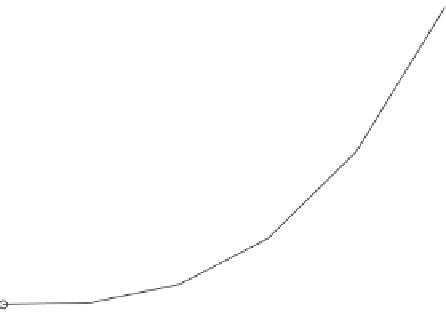Image Processing Reference
In-Depth Information
Example 6.1
Consider the 1-D LUT given in Table 6.2. Use linear interpolation to interpolate
the value of the function at x ¼
5.4.
S
OLUTION
Figure 6.2 shows the plot of function y¼ f(x). As seen from this
gure, we have
y
i
þ
1
y
i
x
iþ1
x
i
3
:
3
1
:
62
y ¼
ð
x x
i
Þ y
i
¼
(5
:
4
6)
þ
3
:
3
¼
2
:
796
6
4
In the 2-D case, the underlying function is a function of two variables, z
¼
f(x, y),
and the nodes in the LUT are uniformly spaced on grids, as shown in Figure 6.3.
Assume that we would like to interpolate the value of the function z at point a with
coordinates (x, y). Let point a be within the grids b
-
e as shown in Figure 6.4. Then
the bilinear interpolated value of the function at point a is given by
z
¼
f
(
x, y
) ¼
p
00
þ
tp
01
p
00
ð
Þ þ
up
10
p
00
ð
Þ þ
tu p
11
p
01
p
10
p
00
ð
Þ
(
6
:
3
)
where
u and t are the relative distances from the surrounding nodes
p
00
, p
01
, p
11
, and p
10
are the values of the function f(x, y) at points b, c, d, and e,
respectively, as shown in Figure 6.4.
TABLE 6.2
Example of a Uniform LUT
x
0
2
4
6
8
10
y
0.9
0.98
1.62
3.3
6.5
11.8
12
10
8
6
4
2
0
0
1
2
3
4
5
6
7
8
9
10
x
FIGURE 6.2
Plot of function f(x).













































































































Search WWH ::

Custom Search